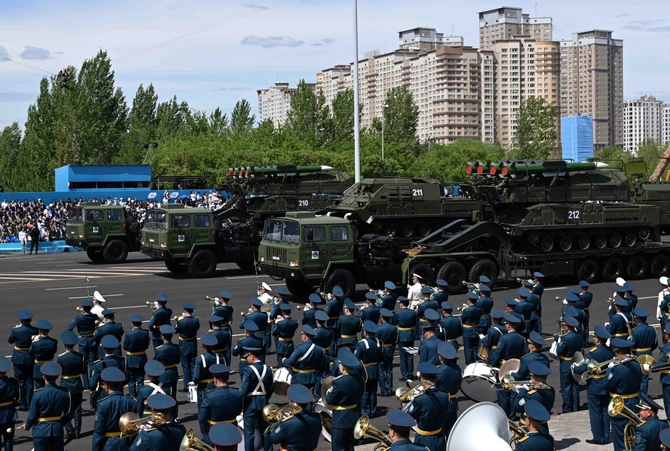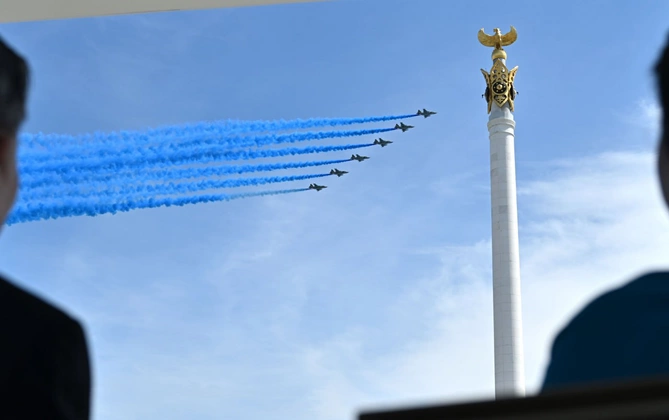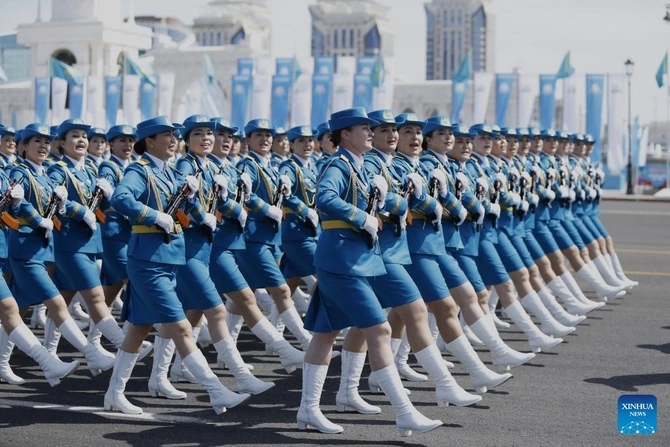
Large-scale Victory Parade in Astana on May 7, featuring historic and modern combat vehicles. Photo credit: Aqorda
The recent military parade held in Kazakhstan for the first time in five years has sparked significant interest among experts in the country’s defense sector.
Speaking at the event, the Commander-in-Chief and President of Kazakhstan, Kassym-Jomart Tokayev, identified strengthening the nation's defense capabilities as one of Astana’s top priorities. He announced a decisive course toward the modernization of the Armed Forces and enhancing the army’s capacity, describing it as “a pillar of the country’s independence,” as Kazakh soldiers “steadfastly defend the nation’s territorial integrity, public order, and the peaceful life of its citizens.” Tokayev also reaffirmed that the state will continue to support military personnel, members of special services, and civil defense units.

Led by Ground Forces Commander Major General Mereke Koshekbai, the parade included 26 formations from nearly every branch of the armed forces. Photo credit: Aqorda
Experts noted that this statement echoes Tokayev’s earlier remarks made in April 2025, in which he emphasized that the Armed Forces are one of the main pillars of Kazakhstan’s sovereignty and independence. That same month, the Mazhilis of Kazakhstan’s Parliament passed the second reading of the draft law “On Territorial Defense,” aimed at protecting the country’s territorial integrity, enhancing its defense capacity, and ensuring civilian security during mobilization, martial law, and wartime. The law introduced legal definitions for terms such as “self-defense formations,” “volunteer,” and “territorial defense facility.”
In addition, Kazakhstan’s current Law on National Security includes provisions under “Fundamental National Interests” that focus on ensuring the combat readiness and mobilization capacity of the Armed Forces and other military units, as well as enhancing military equipment and the development of domestic defense industry enterprises capable of fully meeting the country’s security needs.
Kazakhstan’s growing military potential is also reflected in the latest Global Firepower ranking for 2025, where the country moved up to 57th place worldwide-one position higher than in 2024 and six places higher than in 2023-making Kazakhstan the leading military power in Central Asia. According to the Global Firepower Index, Kazakhstan’s defense budget exceeds $2 billion, and its armed forces number approximately 110,000 personnel.
Experts also highlight Kazakhstan’s position as 17th in the world for the number of Multiple Launch Rocket Systems (MLRS), with 407 units, and 21st for self-propelled artillery systems. The country operates more than 40 defense industry enterprises producing a wide range of equipment, including armored vehicles, naval vessels, aircraft, night vision systems, fire control systems, helmets, munitions, and other military products. In 2024, Kazakhstan’s ground forces received new armored vehicles such as the “Arlan” and Cobra II models. Significant attention has been given to unmanned systems, with the acquisition of tactical UAVs like the “SUNQAR” and the mini-UAV “EVOMax,” enhancing reconnaissance and surveillance capabilities. Tests of the heavy ANKA drone also continued. Notably, the country strengthened its airlift capacity with the delivery of its first A400M heavy transport aircraft.

Sixty-six aircraft flew over the capital in combat formation. Photo credit: Aqorda
A key development this year was the announcement by Kazakhstan’s Minister of Defense, Ruslan Zhaksylykov, regarding plans to establish a major defense industry center at the only tank repair plant in Central Asia, located in the city of Semey. The center is expected to not only service and upgrade military equipment but also launch domestic production of weapons and components.
According to figures released by the Ministry of Finance in December 2024, Kazakhstan’s defense budget for 2025 is set at 0.44% of GDP, with the state defense procurement budget at 0.24%, bringing total defense spending to 0.68% of GDP.
Equally important is Kazakhstan’s growing military cooperation with partner nations, particularly Azerbaijan. This was demonstrated in April 2025 when defense officials from both countries held staff-level consultations in Kazakhstan to prepare for the joint naval exercises “Caspian Breeze 2025.” Also in April, representatives of Kazakhstan’s Air Force met with their Azerbaijani counterparts in Baku to discuss coordination and joint operations for urgent flight missions. These efforts build on the bilateral Agreement on Defense Intelligence Cooperation signed in 2024 for a five-year term.

Kazakh troops march during a military parade of the armed forces to mark the 80th Anniversary of the Victory of the World Anti-Fascist War in Astana, Kazakhstan, on May 7, 2025. (Photo: Xinhua)
In conclusion, the facts presented clearly indicate Kazakhstan’s significant and steadily growing defense potential. In an era of ongoing global geopolitical turbulence, this progress takes on particular importance. Kazakhstan is positioning itself not merely as an observer of international developments but as a strong and responsible player in regional and global security. By advancing its domestic defense industry and deepening military partnerships with friendly nations, Kazakhstan is laying the groundwork for safeguarding its sovereignty, maintaining stability, and contributing to the broader architecture of international security.
Share on social media